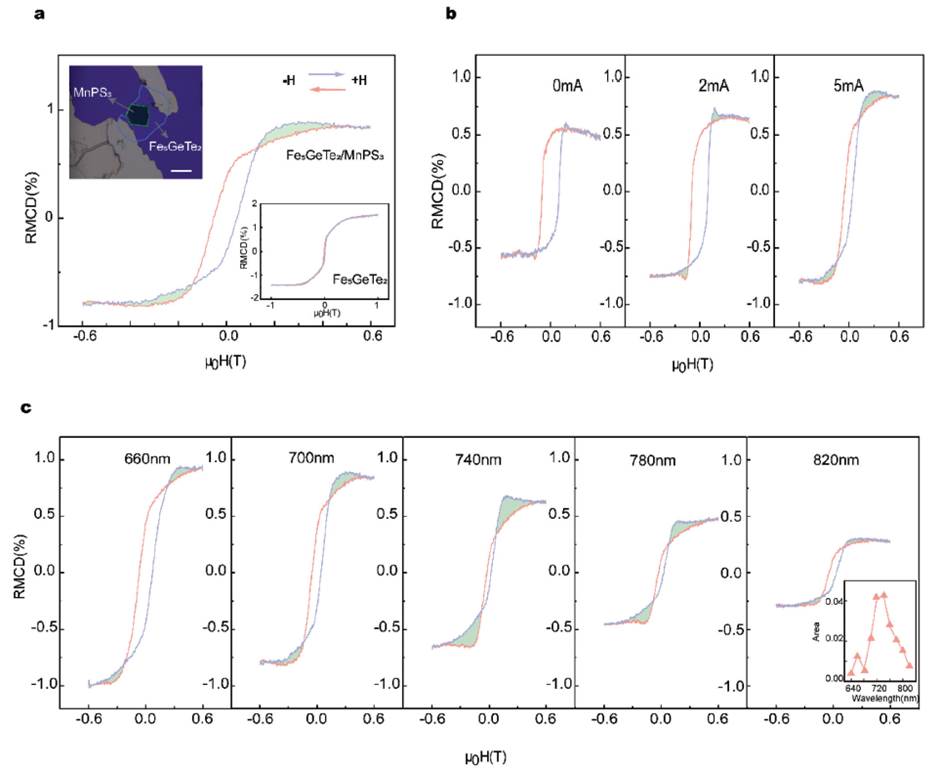
Figure 1.(a)Anomalous RMCD in Fe5GeTe2/MnPS3 heterostructures at 10 K with an in-plane current of 5 mA applied. The green-shaded area is distinct from the ordinary RMCD signal. The top-left inset shows a microscope image of the Fe5GeTe2/MnPS3 heterostructure device, and the bottom-right inset shows the ordinary RMCD of Fe5GeTe2.The scale bar is 10 um.(b) Current-dependent anomalous RMCD results at 10 K of 700 nm. (c) Anomalous RMCD results as a function of wavelength with an applied in-plane current of 5 mA at 10 K in Fe5GeTe2/MnPS3. The inset shows the amplitude of the anomalous RMCD with wavelength.
Background
Two-dimensional (2D) ferromagnet is a good platform to investigate topological effects and spintronic devices owing to its rich spin structures and excellent external-field tunability. The appearance of the topological Hall Effect is often regarded as an important sign of the generation of chiral spin textures, like magnetic vortexes or skyrmions. Here, interface engineering and an in-plane current were used to modulate the magnetic properties of the nearly room-temperature 2D ferromagnet Fe5GeTe2. An artificial topology phenomenon was observed in the Fe5GeTe2/MnPS3 heterostructure by using both anomalous Hall Effect and reflective magnetic circular dichroism (RMCD) measurements.
What is discovered?
We discovered that the formation of inhomogeneous magnetic domains at the interface and in the Fe5GeTe2 is responsible for the hump-like feature rather than the THE. Furthermore, we point out that interfacial effects and the current manipulation could tune the magnetic properties of 2D vdW materials.
What is important?
Our work provides a deeper understanding of topological phenomena and may promote the development of skyrmion-based devices in 2D magnetic materials.
Why did we need WHMFC?
MOKE is a powerful tool for investigation of 2D ferromagnetic materials. The lab-build MOKE setup in WHMFC provides a magnetic field of 0-2.5 T, temperature range of 4.2-300 K, and space resolution of 3 μm, and it played an important role in ferromagnetism characterizations in Fe5GeTe2/MnPS3 Heterostructuresin this work.
Who did the research?
X. D. Chen, M. S. Li, Q. H. Hao, M. H. Cai, H. W. Dai, H. J. Chen, Y. T. Xing, X. Wang and Prof. J. B. Han*
Wuhan National High Magnetic Field Center and Department of Physics, Huazhong University of Science and Technology, Wuhan, 430074, China E-mail:junbo.han@mail.hust.edu.cn
H. Y. Wang, J. Liu, Prof. T. Y. Zhai and Prof. X. Zhou,*
State Key Laboratory of Materials Processing and Die & Mould Technology, School of Materials Science and Engineering, Huazhong University of Science and Technology, Wuhan, 430074, P. R. China
Prof. X. Wang
School of elementary education Wuhan City Polytechnic College Wuhan 430070, P. R. China
Link
https://doi.org/10.1002/advs.202207617
